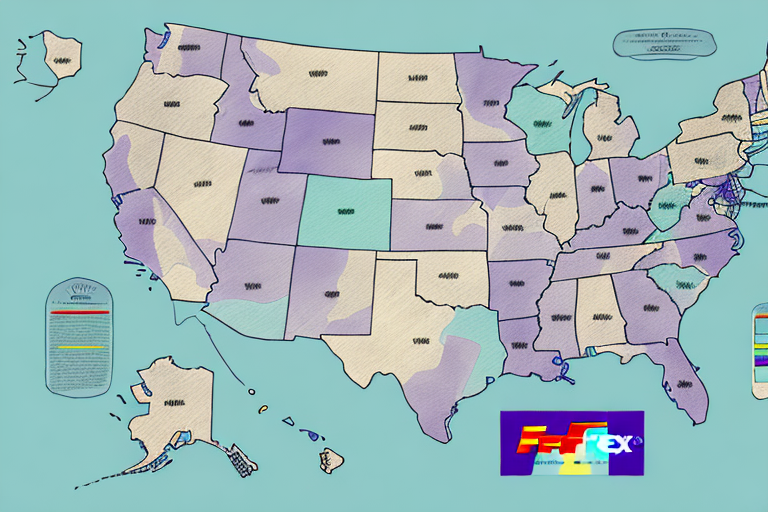Understanding FedEx SmartPost Rates and Zones
FedEx SmartPost is a hybrid shipping service offered by FedEx that leverages the efficiency of FedEx's extensive transportation network combined with the cost-effective last-mile delivery capabilities of the U.S. Postal Service (USPS). This partnership allows businesses to ship packages using FedEx's reliable network, with USPS handling the final delivery to the customer's doorstep. For businesses that ship regularly and seek economical shipping solutions, FedEx SmartPost presents a compelling option.
What is FedEx SmartPost and How Does It Work?
FedEx SmartPost is a service designed for shipping packages weighing up to 70 pounds within the United States. When utilizing FedEx SmartPost, packages are initially handled by FedEx and transported through their network to a USPS facility near the delivery destination. The USPS then completes the final mile of delivery, bringing the package directly to the customer's address.
The USPS’s expansive network of post offices and mail carriers enables FedEx SmartPost to deliver to areas that might be challenging for FedEx alone, all while maintaining lower shipping costs. This makes it an attractive option for businesses aiming to balance cost and reach.
One significant advantage of FedEx SmartPost is the comprehensive package tracking system. Businesses can monitor shipments through the FedEx website during transit and switch to the USPS tracking system as the package enters the final delivery phase. This dual tracking ensures transparency and reliability, allowing businesses and customers to stay informed about delivery status.
How Are FedEx SmartPost Rates Calculated?
FedEx SmartPost rates are determined based on several factors, including:
- Package Weight and Dimensions: Heavier and larger packages incur higher shipping costs.
- Shipping Distance: Longer distances between the origin and destination increase the rate.
- Delivery Speed: Faster delivery options come at a premium.
- Fuel Surcharges: Fluctuating fuel prices can impact overall shipping costs.
- Handling Fees: Packages exceeding specific size or weight thresholds may attract additional fees.
For an accurate estimate of shipping costs, businesses can utilize FedEx’s online rate calculator. By inputting package details, delivery locations, and desired delivery speeds, the tool provides precise cost estimates tailored to specific shipping needs.
It's important to note that FedEx SmartPost is best suited for non-urgent shipments. For time-sensitive deliveries, services like FedEx Express may be more appropriate despite higher costs.
Additionally, businesses with high shipping volumes can benefit from discounted rates through FedEx’s volume shipping programs, making SmartPost even more cost-effective.
Factors That Affect FedEx SmartPost Rates and Zones
Several factors influence FedEx SmartPost rates and zone classifications:
- Package Weight and Dimensions: Adhering to FedEx’s weight and size restrictions is crucial to avoid additional fees.
- Shipping Distance: Greater distances result in higher shipping costs.
- Delivery Speed: Faster delivery options increase the overall shipping rate.
- Package Type: Fragile or hazardous items may require special handling, leading to extra charges.
- Seasonal Demand: Peak seasons, such as holidays, can lead to higher rates due to increased shipping demand.
Understanding these factors helps businesses optimize their shipping strategies to minimize costs while ensuring timely deliveries.
Understanding the Different Zones for FedEx SmartPost
FedEx SmartPost categorizes shipments into eight distinct zones, ranging from Zone 1 (closest) to Zone 8 (farthest). The zone classification is primarily based on the distance between the package’s origin and destination, directly influencing the shipping rate.
To determine the appropriate zone for a shipment, businesses can use FedEx’s zone locator tool. By entering the origin and destination ZIP codes, the tool accurately assigns the shipment to the corresponding zone.
Delivery times vary by zone. Typically, packages in Zone 1 are delivered within 2-3 business days, whereas Zone 8 shipments may take up to 7 business days. Additionally, larger or heavier packages might experience longer delivery times due to increased handling requirements.
Using Technology to Optimize Your FedEx SmartPost Rates and Zones
Leveraging technology is essential for optimizing FedEx SmartPost rates and zone assignments. Various shipping software solutions can streamline the shipping process by:
- Calculating the most cost-effective shipping methods based on package details and delivery requirements.
- Optimizing package weights and dimensions to reduce shipping costs.
- Integrating with e-commerce platforms to automate shipping cost calculations and label generation.
Implementing such software not only reduces shipping expenses but also minimizes the risk of errors, ensuring a smoother shipping experience for both businesses and their customers.
Tips for Reducing Your FedEx SmartPost Shipping Costs
Businesses looking to minimize FedEx SmartPost shipping costs can consider the following strategies:
- Optimize Package Size and Weight: Use appropriately sized packaging to avoid unnecessary weight and dimensional fees.
- Negotiate Rates: High-volume shippers may qualify for discounted rates through FedEx’s volume shipping programs.
- Compare Shipping Methods: Evaluate alternative shipping options like USPS or UPS to identify the most cost-effective solutions.
- Plan Ahead: Scheduling shipments in advance can help avoid rush fees and take advantage of lower rates during non-peak times.
Is FedEx SmartPost the Best Option for Your Shipping Needs?
The suitability of FedEx SmartPost depends on specific business requirements. It is ideal for businesses seeking a cost-effective shipping solution for packages up to 70 pounds with flexible delivery times. However, for businesses that require expedited shipping or have specialized delivery needs, alternative services like FedEx Express or UPS might be more appropriate.
How to Choose the Right Shipping Carrier for Your Business
Selecting the right shipping carrier involves evaluating several factors:
- Package Weight and Dimensions: Ensure the carrier can accommodate your typical package sizes and weights.
- Delivery Speed: Assess how quickly you need packages to reach customers.
- Delivery Locations: Consider whether the carrier can efficiently deliver to all your target areas.
- Shipping Volume: High shipping volumes may qualify you for better rates or specialized services.
- Special Delivery Requirements: Determine if your shipments require additional services like insurance, tracking, or special handling.
By carefully analyzing these factors, businesses can select a shipping carrier that aligns with their operational needs and budget constraints.
Comparing FedEx SmartPost Rates with Other Carriers
When evaluating shipping options, it’s essential to compare FedEx SmartPost rates with those of other carriers to ensure cost-effectiveness. Generally, FedEx SmartPost offers competitive rates, particularly for high-volume shipments. However, rates can vary based on package specifics and service requirements.
Using comparison tools or consulting with shipping experts can help businesses identify the most economical shipping solutions tailored to their unique needs. This is especially crucial for businesses that manage large shipping volumes, where small rate differences can result in significant savings over time.
Common Mistakes to Avoid When Using FedEx SmartPost
To maximize the benefits of FedEx SmartPost, avoid the following common mistakes:
- Poor Packaging: Inadequate packaging can lead to damaged goods, delays, and additional fees.
- Incorrect Labeling: Mislabeling can cause routing errors, leading to delayed or lost shipments.
- Choosing Inappropriate Delivery Speeds: Selecting a delivery speed that doesn’t match the shipment’s urgency can result in unnecessary costs or delayed deliveries.
- Ignoring Zone Classifications: Failing to account for zones can lead to higher shipping costs or extended delivery times.
Best Practices for Packaging and Labeling Your Shipments with FedEx SmartPost
Ensuring proper packaging and labeling is crucial for a seamless FedEx SmartPost experience:
- Select the Right Box Size: Use boxes that fit the contents snugly to prevent movement and damage during transit.
- Use Quality Packing Materials: Incorporate bubble wrap, packing peanuts, or other cushioning materials to protect fragile items.
- Secure Packages with Durable Tape: Reinforce all seams and edges with strong packing tape to ensure package integrity.
- Clearly and Accurately Label Packages: Ensure labels are legible and placed prominently to facilitate efficient handling and delivery.
Adhering to these best practices helps minimize shipping disruptions and ensures packages arrive safely and on time.
Understanding Delivery Times and Tracking Options with FedEx SmartPost
Delivery times for FedEx SmartPost typically range from 2 to 7 business days, depending on the designated zone and package specifics. Factors influencing delivery times include:
- Shipping Distance: Longer distances generally require more transit time.
- Package Size and Weight: Larger or heavier packages may take longer to process and deliver.
FedEx SmartPost offers robust tracking options, allowing businesses and customers to monitor the status of shipments in real-time. Tracking can be accessed via the FedEx website during the transit phase and through the USPS system during final delivery. Additionally, notifications can be set up to receive updates via email or text message upon shipment, in transit, and delivery completion.
Strategies for Improving Customer Satisfaction with FedEx SmartPost Shipments
Enhancing customer satisfaction with FedEx SmartPost involves several key strategies:
- Provide Accurate Delivery Estimates: Clearly communicate expected delivery times to set proper customer expectations.
- Offer Real-Time Tracking: Enable customers to track their shipments, increasing transparency and trust.
- Ensure Secure Packaging: Properly package items to prevent damage and ensure they arrive in excellent condition.
- Communicate Proactively: Inform customers of any potential delays or issues promptly to maintain confidence.
Implementing these strategies can lead to higher customer satisfaction, repeat business, and positive reviews.
Case Studies: Businesses That Have Successfully Lowered Their Shipping Costs with FedEx SmartPost
Several businesses have effectively reduced their shipping expenses by integrating FedEx SmartPost into their logistics strategies:
- XYZ Company: By switching to FedEx SmartPost, XYZ Company decreased its shipping costs by 30%, allowing for more competitive pricing and increased profitability.
- ABC Corporation: Utilizing shipping software to optimize their FedEx SmartPost shipments, ABC Corporation achieved a 15% reduction in shipping expenses while maintaining delivery efficiency.
These success stories highlight the potential cost-saving benefits of FedEx SmartPost when implemented alongside strategic planning and the right tools.
Additional Resources
For more detailed information and updates on FedEx SmartPost rates and services, visit the ShipScience website.



















